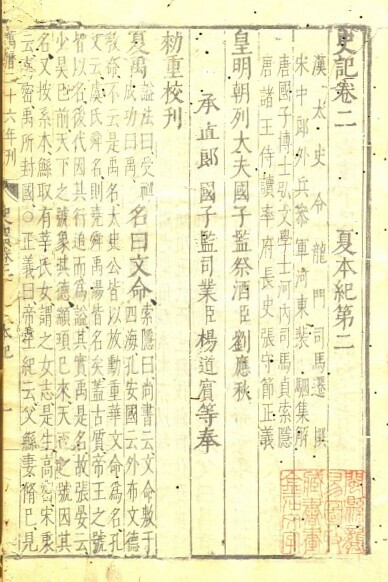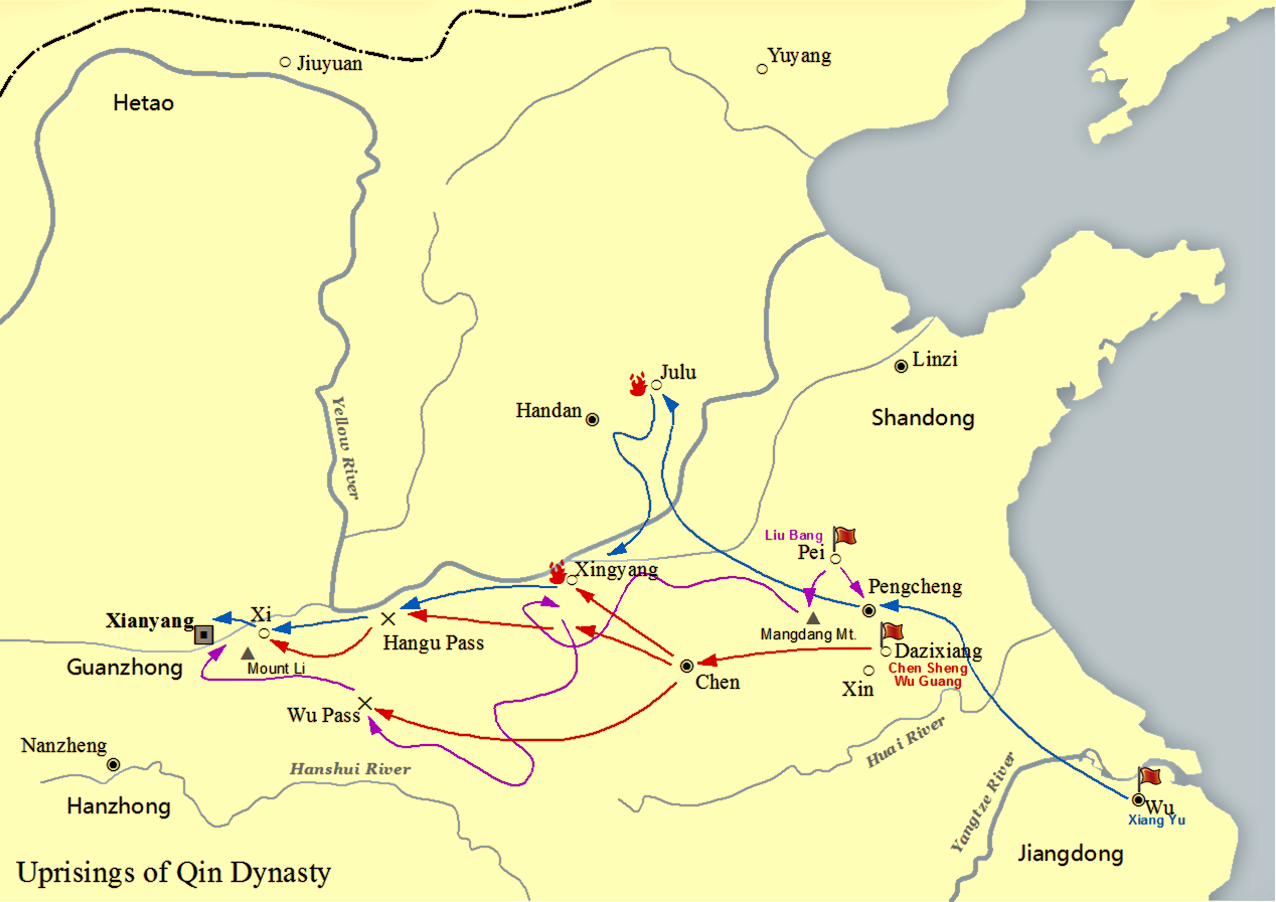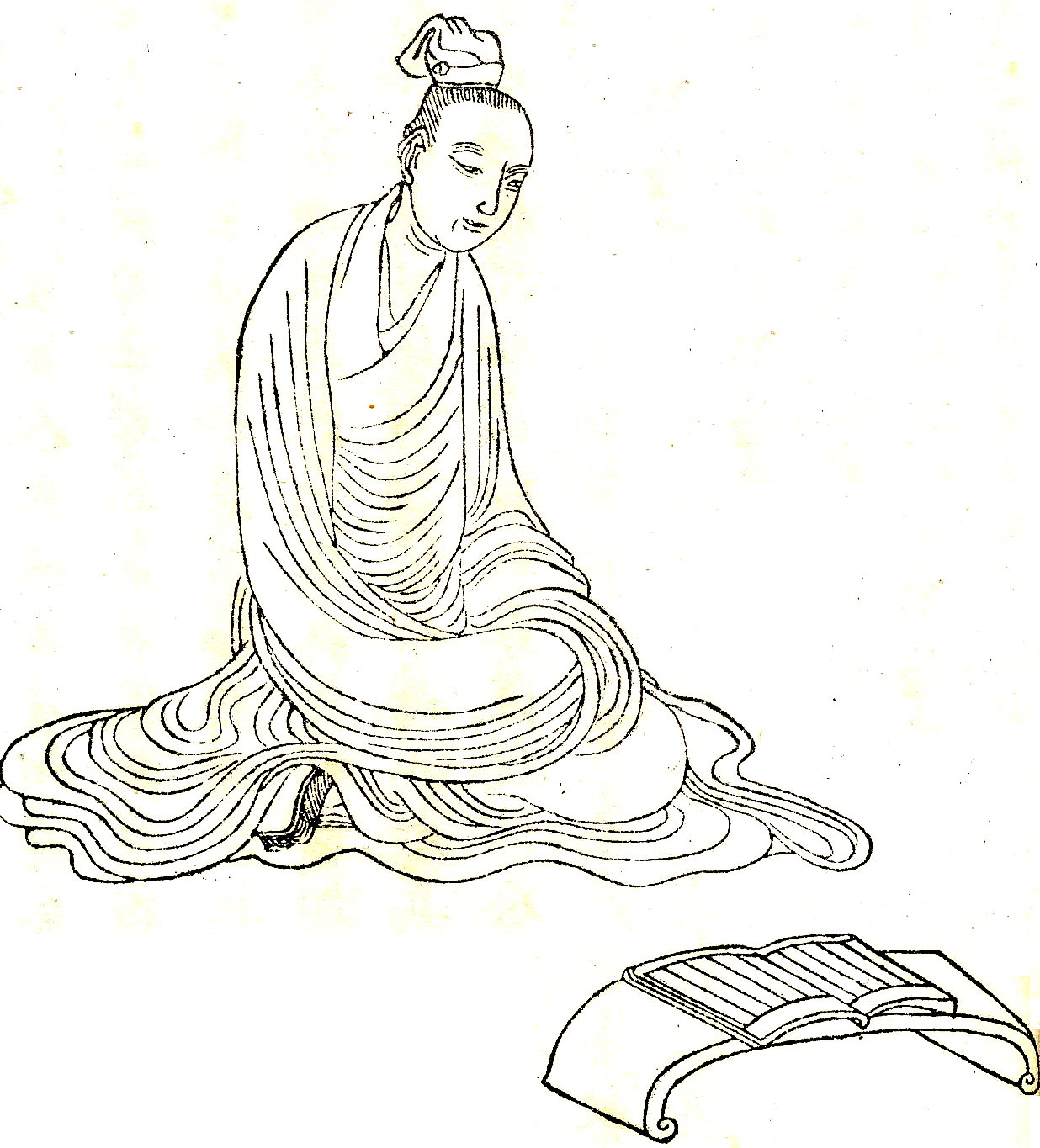|
Cheng, King Of Han
Han Cheng (died 206 BC), also referred to as Cheng, King of Han in some Chinese historical texts, was a ruler of the Kingdom of Hán () of the Eighteen Kingdoms during the Chu–Han Contention, an interregnum between the Qin and Han dynasties of China. Life Han Cheng was a descendant of the royal family of the Hán state during the Warring States period. He lived as a commoner during the Qin dynasty after his native state was conquered by the Qin state in 230 BC. In 209 BC, when uprisings against the Qin dynasty broke out throughout China, Han Cheng joined Xiang Liang's rebel group, hoping to leverage on their military power to revive the Hán state. Along the way, he met Zhang Liang, a descendant of a bureaucratic family of the former Hán state. Zhang Liang succeeded in persuading Xiang Liang to restore the former Hán state, and Han Cheng was appointed as its ruler with Zhang Liang serving as his chancellor. Xiang Liang also provided some troops to Han Cheng and allowed ... [...More Info...] [...Related Items...] OR: [Wikipedia] [Google] [Baidu] |
Han (Warring States)
Han was an ancient Chinese state during the Warring States period. Scholars frequently render the name as Hann to clearly distinguish it from China's later Han dynasty. It was located in central China (modern-day Shanxi and Henan) in a region south and east of Luoyang, the capital of the Eastern Zhou. It was ruled by aristocrats of the Ji ( 姬) family ancestral temple who rose to power as a ministerial family in the state of Jin, and whose power eventually eclipsed that of the Jin ruling house. The partition of Jin which resulted in the states of Han, Wei, and Zhao, marked the beginning of the Warring States period. The state of Han was small and located in a mountainous and unprofitable region. Its territory directly blocked the passage of the state of Qin into the North China Plain.. Although Han had attempted to reform its governance (notably under Chancellor Shen Buhai who improved state administration and strengthened its military ability) these reforms were not enoug ... [...More Info...] [...Related Items...] OR: [Wikipedia] [Google] [Baidu] |
Xiang Liang
Xiang Liang (; died 208 BC) was a Chinese military leader who led a rebellion against the Qin dynasty between 209 and 208 BC. He is best known as an uncle of Xiang Yu, the rival of the Han dynasty's founding emperor Emperor Gaozu of Han, Liu Bang during the Chu–Han Contention. Early life Xiang Liang was from Xiaxiang (; present-day Suqian, Jiangsu) and he descended from an aristocratic family whose members had served as generals in the Chu (state), Chu state during the Warring States period. His father, Xiang Yan (), had been killed in action in 223 BC while leading the defence of Chu against Qin's wars of unification#Conquest of Chu, an invasion by the Qin (state), Qin state, which ultimately unified China under the Qin dynasty. After the fall of Chu, the Xiang family lived as commoners under Qin rule for years. When Xiang Liang's brother Xiang Chao () died, Xiang Liang took Xiang Chao's son, Xiang Yu, under his care. Having high hopes for his nephew, Xiang Liang went to grea ... [...More Info...] [...Related Items...] OR: [Wikipedia] [Google] [Baidu] |
Chinese Kings
The Chinese sovereign was the ruler of a particular monarchical regime in the historical periods of ancient China and imperial China. Sovereigns ruling the same regime, and descended from the same paternal line, constituted a dynasty. Several titles and naming schemes have been used throughout Chinese history. Sovereign titles Emperor The characters ''Huang'' (皇 huáng "august (ruler)") and ''Di'' (帝 dì "divine ruler") had been used separately and never consecutively (see Three August Ones and Five Emperors). The character was reserved for mythological rulers until the first emperor of Qin (Qin Shi Huang), who created a new title ''Huangdi'' (皇帝 in pinyin: huáng dì) for himself in 221 BCE, which is commonly translated as ''Emperor'' in English. This title continued in use until the fall of the Qing dynasty in 1912. From the Han dynasty, the title ''Huangdi'' could also be abbreviated to ''huang'' or ''di''. The former nobility titles ''Qing'' (卿), ''Dai ... [...More Info...] [...Related Items...] OR: [Wikipedia] [Google] [Baidu] |
Records Of The Grand Historian
The ''Shiji'', also known as ''Records of the Grand Historian'' or ''The Grand Scribe's Records'', is a Chinese historical text that is the first of the Twenty-Four Histories of imperial China. It was written during the late 2nd and early 1st centuries BC by the Han dynasty historian Sima Qian, building upon work begun by his father Sima Tan. The work covers a 2,500-year period from the age of the legendary Yellow Emperor to the reign of Emperor Wu of Han in the author's own time, and describes the world as it was known to the Chinese of the Western Han dynasty. The ''Shiji'' has been called a "foundational text in Chinese civilization". After Confucius and Qin Shi Huang, "Sima Qian was one of the creators of Imperial China, not least because by providing definitive biographies, he virtually created the two earlier figures." The ''Shiji'' set the model for all subsequent dynastic histories of China. In contrast to Western historiographical conventions, the ''Shiji'' does no ... [...More Info...] [...Related Items...] OR: [Wikipedia] [Google] [Baidu] |
Zheng Chang
Zheng Chang was a ruler of the Kingdom of Hán of the Eighteen Kingdoms during the Chu–Han Contention, an interregnum between the Qin and Han dynasties of China. Zheng Chang was initially the magistrate of Wu County (present-day Suzhou, Jiangsu) during the Qin dynasty. He was an acquaintance of Xiang Yu, and had followed the latter in rebelling against the Qin dynasty around 209 BC. After the fall of the Qin dynasty in 206 BC, Xiang Yu divided the former Qin territories into the Eighteen Kingdoms, and appointed Han Cheng as the King of Hán. Months later, Xiang Yu killed Han Cheng and replaced him with Zheng Chang. Later that year, Hán Xin attacked the Hán kingdom with support from Liu Bang Emperor Gaozu of Han (2561 June 195 BC), also known by his given name Liu Bang, was the founder and first emperor of the Han dynasty, reigning from 202 to 195 BC. He is considered by traditional Chinese historiography to be one o ... and defeated Zheng Chang, ... [...More Info...] [...Related Items...] OR: [Wikipedia] [Google] [Baidu] |
Xiang Yu
Xiang Yu (), born Xiang Ji, was a Chinese warlord who founded and led the short-lived ancient Chinese states, kingdom-state of Western Chu during the interregnum period between the Qin dynasty, Qin and Han dynasty, Han dynasties of China, dynasties known as the Chu–Han Contention (206–202 BC). A nobleman of the former state of Chu, Xiang Yu rebelled against the Qin dynasty under the command of his uncle Xiang Liang, and was granted the title of "Duke of Lu" () by Emperor Yi of Chu, King Huai II of the restoring Chu state in 208 BC. The following year, he led an outnumbered Chu army to victory at the Battle of Julu against the Qin armies led by Zhang Han (Qin dynasty), Zhang Han. After the fall of Qin, Xiang Yu divided the country into a federacy of Eighteen Kingdoms, among which he was self-titled as the "Hegemon-King of Western Chu" () and ruled a vast region spanning central and eastern China, with Pengcheng as his capital. Although a formidable warrior and milita ... [...More Info...] [...Related Items...] OR: [Wikipedia] [Google] [Baidu] |
Yingchuan Commandery
Yingchuan Commandery ( zh, 潁川郡) was a Chinese commandery from the Warring States period to Tang dynasty, located in modern central Henan province. The name referred to the Ying River, which flowed through its territory. The commandery was established by the state of Qin after it conquered Hán. The seat was Yangdi (陽翟, modern Yuzhou, Henan), which, according to legend, was the capital of Yu the Great, and was the capital of the Warring States era State of Han. After the establishment of Hàn dynasty, it originally became Xin, King of Hán's fief. However, Xin was soon moved to Taiyuan, and the commandery was restored. In 2 AD, it administered 20 counties: Yangdi, Kunyang (昆陽), Yingyang (潁陽), Dingling (定陵), Changshe (長社), Xinji (新汲), Xiangcheng (襄城), Yan (郾), Jia (郟), Wuyang (舞陽), Yingyin (潁陰), Chonggao (崇高), Xu (許), Yanling (傿陵), Linying (臨潁), Fucheng (父城), Cheng'an (成安), Zhouchengxiu (周承休), Ya ... [...More Info...] [...Related Items...] OR: [Wikipedia] [Google] [Baidu] |
Zhang Liang (Western Han)
:''Note: In this article, to distinguish between the Han state of the Warring States period and the Han dynasty, the former is referred to as "Hán" while "Han" is reserved for the latter.'' Zhang Liang ( 251 BC – 189 BC), courtesy name Zifang, was a Chinese military strategist and politician who lived in the early Western Han dynasty. He is also known as one of the "Three Heroes of the early Han dynasty" (), along with Han Xin () and Xiao He. Zhang Liang contributed greatly to the establishment of the Han dynasty. After his death, he was honoured with the posthumous title "Marquis Wencheng" by Emperor Qianshao. Zhang Liang is depicted in the Wu Shuang Pu (無雙譜, Table of Peerless Heroes) by Jin Guliang. Early life Zhang Liang was born in Xinzheng (新鄭; present-day Zhengzhou, Henan), the capital of the Hán state (), while his ancestral home was in Chengfu (城父; present-day Chengfu Town, Bozhou, Anhui). He descended from an aristocrat family in Hán. His grandfa ... [...More Info...] [...Related Items...] OR: [Wikipedia] [Google] [Baidu] |
Qin (state)
Qin (, , or ''Ch'in'') was an ancient Chinese state during the Zhou dynasty. It is traditionally dated to 897 BC. The state of Qin originated from a reconquest of western lands that had previously been lost to the Xirong. Its location at the western edge of Chinese civilisation allowed for expansion and development that was not available to its rivals in the North China Plain. After extensive reform during the 4th century BC, Qin emerged as one of the dominant powers among the Seven Warring States. It Qin's wars of unification, unified the seven states of China under Qin Shi Huang in 221 BC. This unification established the Qin dynasty, which, despite its short duration, had a significant influence on later Chinese history. Accordingly, the state of Qin before the Qin dynasty was established is also referred to as the "predynastic Qin" or "proto-Qin". History Founding According to the 2nd-century BC ''Records of the Grand Historian'' by Sima Qian, the state of Qi ... [...More Info...] [...Related Items...] OR: [Wikipedia] [Google] [Baidu] |
Warring States Period
The Warring States period in history of China, Chinese history (221 BC) comprises the final two and a half centuries of the Zhou dynasty (256 BC), which were characterized by frequent warfare, bureaucratic and military reforms, and struggles for greater hegemonic influence among the ancient Chinese states, various autonomous feudal states of the Eastern Zhou dynasty. It followed the Spring and Autumn period and concluded with the eventual unification of China by the western state of Qin (state), Qin under Qin Shi Huang, who Qin's wars of unification, conquered all other contender states by 221 BC and found the Qin dynasty, the first history of China#Imperial China, imperial dynasty in East Asian history. While scholars have identified several different dates as marking the beginning of the Warring States period, Sima Qian's choice of 475 BC, the first year of King Yuan of Zhou's reign, is the most often cited due to the paucity of preceding annals after th ... [...More Info...] [...Related Items...] OR: [Wikipedia] [Google] [Baidu] |
Qin's Wars Of Unification
Qin's wars of unification were a series of military campaigns launched in the late third century BC by the state of Qin against the other six states remaining in China Han, Zhao, Yan, Wei, Chu and Qi. Between 247 and 221 BC, Qin had developed into the most powerful of China's Seven Warring States that coalesced in the wake of the declining Zhou dynasty, which had been reduced to a weak and merely ceremonial position during the Warring States period. In 230 BC, Ying Zheng, the King of Qin, began the sequence of campaigns that would bring the Warring States period to a close, setting out to conquer each of the six states one by one. This was completed in 221 BC with the fall of Qi, which further led to a more centralised form of government replacing the '' fengjian'' system of the Zhou dynasty. Ying Zheng declared himself the First Emperor – or Shi Huangdi – of a unified China under the Qin dynasty. Background Rise of Qin and early conquests O ... [...More Info...] [...Related Items...] OR: [Wikipedia] [Google] [Baidu] |





